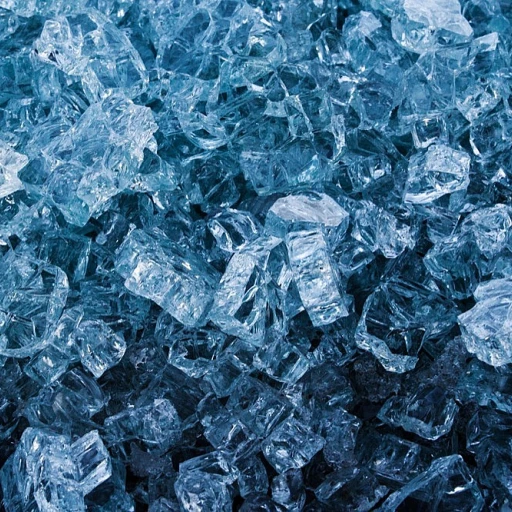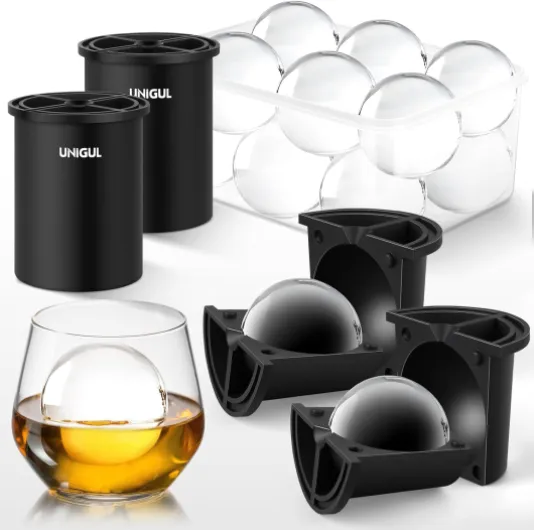Understanding the Science Behind Clear Ice
Understanding How Clear Ice is Formed
Creating crystal clear ice cubes at home can significantly enhance the visual appeal of your cocktails while also improving their taste. The cloudiness often found in standard ice cubes results from air bubbles and impurities in the water. By gaining a deeper understanding of how clear ice is formed, you can make informed decisions when choosing the right equipment and techniques.
Most ice cubes are cloudy because of trapped air and impurities. When water freezes, it does so starting from the outside, pushing air bubbles and impurities into the center where they become trapped as the water solidifies. To achieve that pristine, clear ice look, the process of directional freezing is essential. By controlling the freezing direction, you can force air bubbles and impurities out of the water before it turns into ice.
Key Elements in Perfecting Your Ice
- Water Quality: Start with pure water to minimize impurities. Distilled water, filtered water, or previously boiled water are ideal options to reduce air content and improve clarity.
- Freezing Technique: Utilize an ice maker or tray designed for slow, directional freezing. This ensures that air bubbles and impurities are pushed out of the ice block, resulting in clear ice.
- Temperature Control: Ensure your freezer or cooler maintains a consistent temperature, allowing for gradual freezing. A sudden drop in temperature can create cloudy ice cubes.
Exploring the science of clear ice provides you with the foundational knowledge essential for producing perfectly transparent ice cubes. For more insights on enhancing your ice-making process and understanding different ice types that might benefit your ice-making venture, consider reading about the
benefits of using bullet ice cubes.
Choosing the Right Ice Maker for Clear Ice
Selecting the Optimal Ice Maker
Choosing the right ice maker to craft perfectly clear ice involves understanding what makes one model stand out over others, particularly when aiming to create ice without impurities that turns cloudy. Several factors and features play a critical role in producing ice that can enhance your cocktails and beverages.
- Directional Freezing Capability: An ice maker with directional freezing helps clear ice production by controlling how the ice forms, pushing out impurities and air bubbles. This technique allows water to freeze gradually from one direction, leading to crystal clear ice cubes.
- Water Quality: The type of water you use can dramatically affect the clarity of your ice cubes. Consider models that work optimally with filtered water, distilled water, or even tap water that has been boiled and cooled, as these methods help eliminate impurities. Advanced models might also offer built-in water filtration systems, which are great for ensuring ice clarity.
- Size and Type of Ice: Depending on your preferences and use, different ice makers produce various sizes and shapes of ice cubes. Options can range from large ice block makers to those producing smaller cube trays ideal for cocktail use, avoiding the cloudy ice problem.
- Freezer and Cooler Design: Some advanced ice makers are designed to maintain cooler, controlled environments, which is crucial for reducing air exposure and resulting air bubbles in your ice. A well-designed freezer compartment supports the gradual freezing process essential for clear ice.
When considering an ice maker that produces quality
crystal clear ice, balance your needs with your budget, as units with additional features like internal cooling systems or air purifiers may cost more but offer significant results. Aim for a product that meets your needs while enhancing your beverage presentation, ensuring a clear ice experience that stands out.
Step-by-Step Guide to Making Clear Ice
{"h3":"Steps for Creating Crystal Clear Ice at Home with Your Ice Maker"
- Start with Pure Water: To achieve ice cubes that are free from impurities and crystal clear, use distilled water or filtered water. Tap water often contains minerals and particles that contribute to cloudy ice. Boiled water can work in a pinch, as boiling helps remove air and gases, but for the best results, distilled water is recommended.
- Utilize the Directional Freezing Method: This technique mimics how ice forms in nature, pushing impurities and air bubbles to the bottom of the ice block. Use a special cooler or insulated tray designed for directional freezing. This method ensures the top layers of your ice cubes will be clear while pushing bubbles and impurities towards the base.
- Monitor the Freezer Environment: Once you've prepared the water, place your ice tray in the freezer. Keeping a consistent freezing temperature helps prevent cloudy ice formation. Make sure there is enough space in the freezer for air circulation around the tray.
- Remove Ice Carefully: After the ice has fully frozen, typically within 12 to 24 hours depending on the freezer's temperature, extract the clear ice block from the tray. If using a directional freezing tray, you may need to chip away or cut off the bottom part where impurities and bubbles have settled. This ensures only the clearest portion remains.
- Optional Tools: For those particularly interested in cocktail presentation, using specialized ice cube molds can help form the perfect shape for your clear ice cube. Cube trays designed for larger ice cubes allow for slower melting, preserving the clarity in your drink longer.
- Troubleshooting: If you find that your ice is still cloudy, it could be due to inconsistent temperatures or impurities in the water. Reviewing the setup and process may reveal areas to adjust for optimal results. For more detailed guidance on handling common issues with your ice maker, consider visiting this repair guide.
Common Challenges and Solutions
Navigating the Hurdles: Challenges in Crafting Clear Ice
Creating crystal clear ice cubes for cocktails and other beverages can be a satisfying endeavor, but it is not without challenges. Many aspiring ice enthusiasts encounter several issues along the way. Here’s how to navigate some of the most common obstacles to ensure your ice cubes turn out perfectly clear.
- Air Bubbles and Impurities: One of the primary reasons ice turns out cloudy is due to trapped air bubbles and impurities in the water. To tackle this, use distilled or boiled water, as these methods can minimize the presence of minerals and gases that cause cloudiness.
- Direction of Freezing: The way ice freezes can also impact its clarity. A technique known as directional freezing helps clear out air bubbles and impurities by freezing the water from one direction. By using an insulated cooler or a specialized ice cube tray designed for directional freezing, you can improve the quality of your ice cubes significantly.
- Freezer Temperatures: Freezing your ice cubes too quickly can cause them to crack and become cloudy. Aim for a steady, slow freeze. Setting your freezer to a slightly warmer temperature can allow the ice to freeze gradually, improving clarity.
- Type of Water: Water choice is critical in making clear cubes. Distilled water is often recommended because it has fewer impurities. Filtered water can also be a good option. Tap water is not ideal due to its mineral content and potential impurities.
- Ice Cube Tray: Opt for high-quality, food-grade ice trays or molds. These are specifically designed to create clear and aesthetically pleasing ice cubs without the formation of imperfections.
Overcoming these challenges not only involves the right techniques but also the right equipment, as discussed in choosing the ideal ice maker for clear ice. The tools and methods employed will put you on the path to making superior ice blocks that enhance the visual appeal and taste of your drinks. Remember, clear ice is more than just a visual luxury—it elevates the entire drinking experience by keeping your cocktails cooler longer and without diluting them with impurities often found in cloudy ice.
Enhancing Your Drinks with Clear Ice
Elevating Your Beverage Experience with Crystal Clear Ice
Perfectly clear ice not only elevates the visual appeal of your drinks but also enhances the overall drinking experience. Let's explore how clear ice can take your cocktails, mocktails, and any chilled beverage to the next level.
- Visual Excellence: Clear ice brings a sophisticated appearance to your glass. Unlike cloudy ice cubes, which contain air bubbles and impurities, clear cubes allow you to see your drink through the pristine crystal clear surface. This clarity highlights the colors and textures of your concoctions, providing a visually appealing touch to your presentation.
- Longer Cooling Time: Due to the absence of air bubbles and impurities, clear ice melts at a slower pace than standard ice cubes. This characteristic is beneficial for maintaining the temperature of your drink without diluting it excessively, ensuring that your cocktails or other beverages remain cool for an extended period.
- Amplified Flavor: Clear ice doesn't interfere with the taste of your beverage. Since it doesn’t contain tastes from boiled water or tap water impurities, the full flavor profile of your drink remains intact. This is especially important for those who appreciate the refined nuances of their favorite cocktails.
- Creative Opportunities: The clarity of ice provides a perfect canvas for creativity. You can experiment with different shapes and sizes, utilizing a cube tray or ice block molds to tailor the ice to your specific needs, whether you're aiming for large ice cubes or uniquely shaped ice accessories.
To achieve the best results, focus on perfecting your ice-making techniques and maintain your ice maker diligently. Utilizing directional freezing can also help in crafting clear ice by forcing impurities towards the bottom of the tray, which can be easily discarded. Taking these steps will ensure that only the purest and most appealing crystal clear ice cubes grace your glass, making every sip a delight.
Maintenance Tips for Your Ice Maker
Keep Your Ice Maker Running Smoothly
To keep producing crystal clear ice cubes and maintain the efficiency of your ice maker, regular maintenance is essential. Consistent upkeep will not only lead to longer-lasting equipment but ensures that the quality of the ice remains top-notch, ideal for enhancing cocktails and chilling your favorite drinks. Below are some vital tips:
- Regular Cleaning: Clean the ice maker at least every two months. This involves emptying all ice and water, and using mild dish soap and water to wipe down the interior and exterior surfaces. Regular cleaning prevents impurities and mineral buildup from tap water, maintaining the clarity and taste of your ice.
- Use Quality Water: Using distilled water or filtered water significantly reduces impurities and potential air bubbles, helping to maintain crystal clear ice production. Avoid using raw tap water, which may introduce additional minerals and affect the clarity of the cubes.
- Inspect for Scale and Mineral Buildup: Check for scale buildup especially in areas with hard water. Mineral deposits can affect the freezing process. Applying a descaling solution periodically or using boiling water mixed with vinegar can help remove hard water stains and deposits.
- Check Air Flow: Ensure there is adequate space for air circulation around the ice maker. Restricted air flow can impact the machine’s ability to freeze water efficiently, resulting in cloudy ice or extended freeze times.
- Ensure Proper Freezing Temperatures: Verify that the freezer or cooler operates within the optimal ice-making temperature range. Extreme temperatures can hinder ice production or result in ice cubes that are not as hard, leading to faster melting in drinks.
- Examine Cube Tray: Regularly inspect the ice tray for any cracks or damages. A faulty tray can lead to inconsistencies in ice cube shapes and may affect the freezing process, promoting air bubbles and less clear ice.
- Service Routine: Schedule professional maintenance if the ice maker exhibits unusual noises, declines in ice production, or presents any malfunctions. Professional checks can help diagnose issues early, ensuring uninterrupted production of ice blocks.
By following these steps, you'll maximize the lifespan of your ice maker and continue to enjoy perfectly clear ice cubes. For those who enjoy making clear ice without any hassle, keeping your device well-maintained is the best approach.



-logo-retina.png)